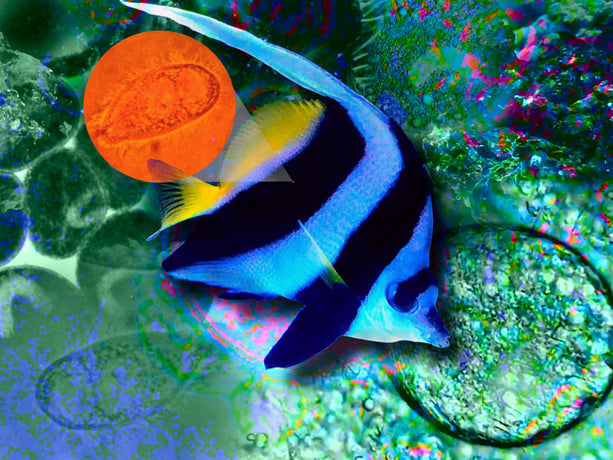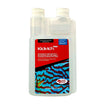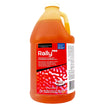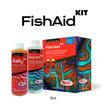- No products in the cart.
How to Properly Treat Ich.
03
Jun
Treating ich can be a huge undertaking for an aquarist. Ruby Reef has researched the biology of the parasite to define a best practice to eradicate and improve the chances to save your fish from dying.
Ich is one of the most common aquarium diseases. Unfortunately, Ich is found on almost all fish and most believe it to be found in every single aquarium.
So, what is Ich exactly? To put it simply, Ich is a parasite that appears on the body, fins and gills of fish. These parasites are small. Real small. So small, in fact, that you need a microscope to see them. The fish appears sprinkled with white grit or coarse sand. Fish rub against hard objects to free themselves of the parasite. If left untreated, Ich will eventually kill your fish. If caught early, Ich is very treatable, and many fish make a full recovery.
Ich is easily transferred from one tank to another by fish, invertebrates, plants, decorations or even maintenance equipment like your gravel vacuum or nets. At pet stores, look for best practices with a separate fish net for every tank. This tells you they are serious about keeping healthy fish by eliminating cross contamination of tanks.
What makes Ich unique among fish diseases is that it has a life cycle.
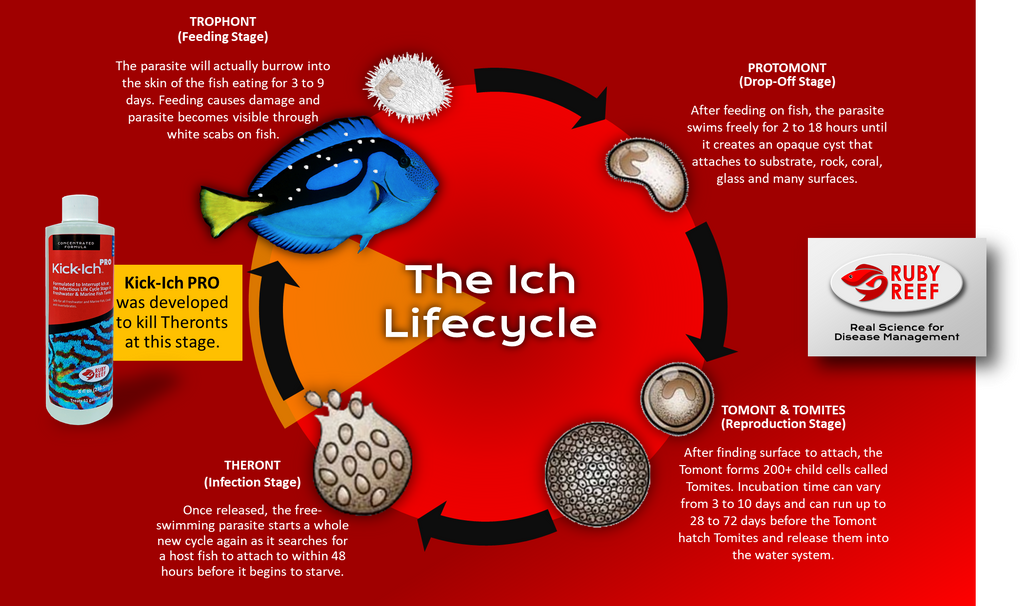
How does Ich get inside your aquarium?
The two main theories that most fishkeepers believe as to how Ich arrived on their fish include:
- It was always on the fish
- It was transferred from tank to tank.
So many fishkeepers believe that the Ich parasite exists in every tank and only infects your fish when conditions are right. Thus making it very important for the fishkeeper to manage the temperature, ammonia, nitrate, nitrite, pH and other water quality parameters to allow your fish’s immune system to keep Ich at bay and allow your fish to recover faster.
How do you identify Ich? (symptoms)
Most fish keepers first identify Ich when their fish breaks out in white spots, randomly scattered across the body, fins and gills. The white specks almost look like someone sprinkled salt over your fish.
At first, it may just be a single spot. On its own, a single spot does not confirm that your fish is suffering from Ich. It could be many other diseases such as velvet (Oodinium), fungus and columnaris can start out as a white-colored spot. However, if more and more white spots appear, it almost certainly is Ich.
This is the only stage where you can visibly see the parasite once it is in the skin of the fish. Many people think the white spot itself is Ich, but it’s actually more like a cyst. The Ich hides behind it.
Fish infected with Ich will not always show visible symptoms of having the parasite, or the parasite may only infect the gills. In these situations, there will be changes in the behavior of the fish that will indicate it is infected with Ich. These behavioral symptoms can include:
- Flashing or scratching like behavior with short bursts of rapid movement,
- Staying near the surface of the tank
- Remaining in a hiding spot and not coming out or staying on the bottom of the tank in a area with lower lighting levels
- Lethargic or longer periods of inactivity
- Rapid breathing or what looks like difficulties breathing
- Losing weight and not eating as normal
It is very important with this parasite to continue dosing for the full treatment period. A break in the medication allows the parasite to multiply and reinfect the fish.
Due to the nature of this parasite, it is normal for the visible signs of infection to get worse before they get better. The medication is still working, but it takes some time for the salt-like cysts on the fish to clear out. Keep up the recommended full treatment cycle and the visible spots should clear soon!
Extensive biological studies have found that attacking the parasite during the Theront Infection Stage is the most effective way to eradicate the Ich parasite.
What are the dangers of Ich to your fish?
If left untreated, Ich will eventually kill your fish. If caught early, Ich is very treatable, and many fish make a full recovery.
The best treatment for infectious diseases is prevention. Best way to prevent ich on your fish is to reduce the chances of the parasite getting on your fish or into your aquarium. Unless the fish has exceptional value, a sick fish should be disposed of before the disease spreads.
New fish should be placed in quarantine and treated prophylactically before being added to a community tank. This is particularly true for a marine or reef tank! If a sick fish is found in a community tank and it has been determined that it should be saved, then quarantine it for treatment with HydroPlex, if possible. Begin treating the tank with Kick-ich Pro and Rally Pro.
Two additional steps to take include a preventative process:
- Adding liquid garlic to food. Garlic is a parasite-fighting superfood and works to boost the immune system of your fish.
- Adjusting the temperature of the aquarium water slowly helps to speed up the Ich lifecycle giving you a better opportunity to get rid of it.
Maybe the best prevention is by Ruby Reef that can be used to prevent the addition of ich into your aquarium. The approach can be applied to a quarantine/hospital tank or as a dip for new arrivals if quarantine tank is not available.
The solution is call HydroPlex. HydroPlex™ is an extremely broad-spectrum dip for cleaning new arrivals of external parasites, bacteria, fungi & algae. HydroPlex also helps to heal open wounds and can be used on hospital/quarantine tanks. HydroPlex™ NANO can be used effectively in new fish transport bags and the small bowls or cups that betta fish are contained.
A simple 10-minute cleansing HydroPlex™ dip bath upon arrival at home, prevents problems before they occur to control and rid fish of harmful bacteria, infectious fungi and algae and external parasites.
